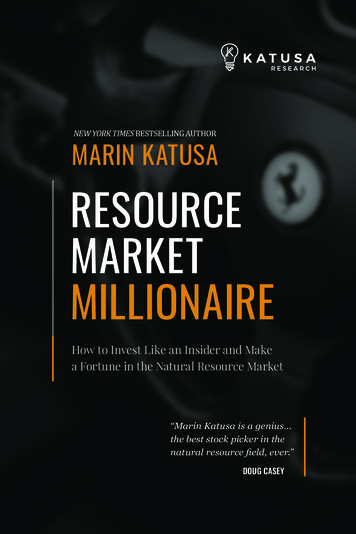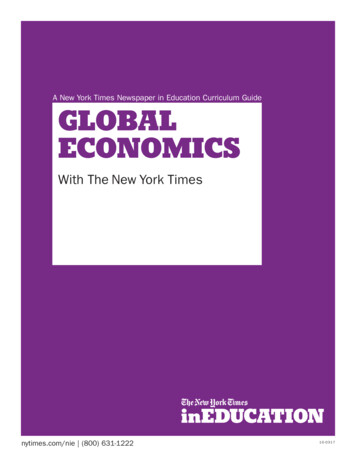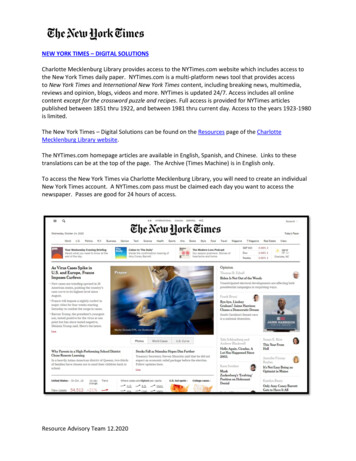
Transcription
NEW YORK TIMES BESTSELLING AUTHORMARIN KATUSARESOURCEMARKETMILLIONAIREHow to Invest Like an Insider and Makea Fortune in the Natural Resource Market“Marin Katusa is a genius the best stock picker in the natural resource field, ever.”DOUG CASEY1
2
RESOURCEMARKETMILLIONAIREHow to Invest Like an Insider and Make a Fortune in the Natural Resource MarketMARIN KATUSAi
2019 Katusa Research. All rights reserved.No part of this publication may be reproduced, copied, ortransmitted in any form without the written consent ofKatusa Research.The Katusa Research website and articles are published byKatusa Research. Information contained in such publicationsis obtained from sources believed to be reliable, but its accuracy cannot be guaranteed. The information contained in suchpublications is not intended to constitute individual investmentadvice and is not designed to meet your personal financial situation. The opinions expressed in such publications are thoseof the publisher and are subject to change without notice. Theinformation in such publications may become outdated andthere is no obligation to update any such information.Marin Katusa, Katusa Research, and other entities in which hehas an interest, employees, officers, family, and associates mayfrom time to time have positions in the securities or commodities covered in these publications or web site. Corporatepolicies are in effect that attempt to avoid potential conflictsof interest and resolve conflicts of interest that do arise in atimely fashion.Any Katusa publication or web site and its content and images,as well as all copyright, trademark and other rights therein,are owned by Katusa Research. No portion of any Katusapublication or web site may be extracted or reproduced without permission of Katusa Research. Nothing contained hereinshall be construed as conferring any license or right underany copyright, trademark or other right of Katusa Research.Unauthorized use, reproduction or rebroadcast of any contentof any Katusa publication or web site, including communicating investment recommendations in such publication or website to nonsubscribers in any manner, is prohibited and shallbe considered an infringement and/or misappropriation of theproprietary rights of Katusa Research.ii
ABOUT KATUSA RESEARCHKatusa Research is an independent investment research firmfounded by professional investor Marin Katusa.Starting from scratch, Marin has built a large personal fortune all through his ability to find great investments.During his career, he has sat on the board of a public company,arranged over 1 billion in financings, and written the New YorkTimes bestselling book, The Colder War.Marin’s insight has been featured in The Wall Street Journal,Fortune magazine, Bloomberg, and CNN. He has traveled over onemillion air miles visiting over 500 resource projects in more than100 countries.Unlike some financial firms, Katusa Research does not acceptmoney from companies in return for coverage. We turn down alloffers of kickbacks, brokerage commissions, and referral fees. We haveno hidden agenda and we are not for sale.We work for our subscribers, not big corporate advertisers. And theinvestment guidance we provide is the guidance we follow ourselves.iii
iv
Co n t e n t sIntroduction.1Chapter 1The Biggest Key (By Far) to MakingHuge Money in Resource Stocks.8Chapter 2The Secret of Making 20-Fold Returns: HowLeverage Works in Natural Resource Stocks.25Chapter 3How to Pick the Right Tool for the Right Job.29Chapter 4An Investment Secret You MightNot Want to Share with Friends.40Chapter 5When Bad Means Good: How to Spota Resource Market Poised to Skyrocket.47Chapter 6The Ultimate Way to Use Other People’s Money.51Chapter 7Why the “Home Run” Mindset is Essentialfor Winning in the Resource Market.55Chapter 8How Many Stocks Should You Own?.60Chapter 9Katusa’s Keys: My Method for Investingin the World’s Best Resource Companies.64Chapter 10 The Resource Per Share Metric: AnEssential Tool for Resource Investors.75Chapter 11 The Biggest Key to Safely Speculatingin Natural Resource Stocks.82Chapter 12 The Way of the Alligator.88Summing Up And Your Next Steps for Success.92v
vi
INTRODUCTIONOn the morning of December 7, 1941, a destroyer operating offthe coast of Hawaii, the USS Ward, was alerted to an object inits area that appeared to be a submarine.The Ward’s skipper, Lt. William Outerbridge, and his crewlocated the object. A periscope was sticking out of the water, whichmeant it was a submarine. The Ward fired her 4-inch deck gun at thesuspicious sub and dropped several depth charges. When it was allover, the sub was at the bottom of the ocean.The crew of the Ward didn’t know it at the time, but the submarine was a small part of a much larger attack headed its way. Just overan hour later, the sky over the nearby naval base at Pearl Harbor wasswarming with attacking Japanese planes.The planes delivered a devastating blow to the United States.Over 2,000 American lost their lives. Over 200 planes were destroyedor damaged. All eight battleships of the U.S. Pacific Fleet were sunkor damaged.The attack, which Japan called “Operation Hawaii,” brought anenraged participant into World War II one that went on to defeatJapan in the largest naval conflict in history.Most people don’t know the USS Ward fired the first shots atPearl Harbor and, thus, in the entire Pacific theater. It’s a story youonly learn if you dig deep into history. And if you dig even more, youlearn another largely unknown aspect of the Pearl Harbor attack only this one is much larger. And it teaches an important lesson Japan didn’t attack Pearl Harbor to send a political message. Itdidn’t attack Pearl Harbor because it was itching to fight the U.S. ina massive global war.The attack on Pearl Harbor, one of the most audacious, mostinfamous military operations in history, was an attempt to securenatural resources, specifically oil.In the years leading up to the attack, Japan had committed atroc1
RESOURCE MARKET MILLIONAIREities all over East Asia. In response, the United States froze Japaneseassets held within its borders. The United States and its allies alsoinstituted an oil embargo on Japan.Since Japan was an island nation with little oil of its own, theembargo was a huge blow to its territorial ambitions. Without oil,Japan’s formidable war machine would stop in its tracks.In a desperate move, Japan’s military leaders decided to punch America in the nose, stagger its naval might, then make a dash for the hugenatural resources of the Dutch East Indies (modern-day Indonesia).You know the rest of the story. America mobilized in a short timeand on a great scale. It devoted its enormous mining and industrialbase to the production of aircraft carriers, submarines, battleships,guns, bombers, tanks, and fighter planes. America launched morenaval vessels in 1941 than Japan did throughout the entire war. In1944, America built more planes than Japan did from 1939 to 1945.America’s incredible mobilization is one for the history books,but fighting over natural resources is nothing new or unique.In 31 BC, the Romans invaded Egypt and made it a province ofthe empire. The biggest allure of the conquest was securing Egypt’svast wheat fields, which were one of the world’s largest sources offood at the time.Europe’s famous “Age of Discovery”—when explorers likeColumbus ventured to the far-off lands of North America, SouthAmerica, Africa, and East Asia—was a brutal age of conquest. It waslargely conducted to acquire spices and precious metals.Control of resources was a major cause of the U.S. Civil War.The reason the South wanted to retain slavery was to support its vastcotton industry, which generated enormous export earnings.Control of resources was a major reason Hitler attacked Russiaduring World War II, one of the pivotal events of the Great War.Hitler wanted Russia’s vast grain and oil resources to supply his warmachine. The German army was crushed in its attempt to take them.Shortly after that attack, Hitler committed suicide.In 1990, Saddam Hussein ordered the invasion of Kuwait. The2
INTRODUCTIONmove was a naked grab for Kuwait’s vast oil wealth. The result wasthe humiliating eviction of Hussein’s forces in the Persian Gulf War.These conflicts (and hundreds of others) serve as bloody reminders; natural resources are the ultimate keys to economic and militarypower. He who has the resources makes the rules. To many, resourcesare worth killing over.Even today’s high-tech world of apps, tweets, and iTunes isbuilt on a “low-tech” foundation of steel, concrete, copper, lumber,and aluminum.Every day, our cars, trucks, and airplanes consume millions of barrels of fuel. Our lights turn on because we burn coal and natural gas.Feeding, clothing, and housing billions of people consumes enormous amounts of agricultural products like corn, wheat, soybeans,rice, cotton, sugar, coffee, lumber, and livestock.Mining, extracting, planting, harvesting, processing, refining, andtransporting these vital resources is a multi-trillion-dollar business thataffects every area of your life. You are only reading these words becausesomeone cut down a tree, or more likely, burned coal or natural gas toproduce the electricity that is powering your computer.Mankind’s constant demand for raw materials ensures thatthe natural resource sector will always be one of the world’s biggest, most important industries.It also ensures that the ownership of the world’s resources willalways be an incredible source of wealth and power. Those who ownthe resources will always enjoy incredible benefits and privilege.Katusa Research will show you how to own the resources.We’re not going to recommend you pick up arms to acquire ownership of the world’s most valuable resources. There are more peacefulmeans to own them these days.But every special report every issue every urgent alert wepublish is done so with a simple goal in mind: To help you turn theworld’s limitless appetite for raw materials into your own personal source ofwealth and power.We hope you’ll your start your campaign with this book 3
RESOURCE MARKET MILLIONAIREwhich we consider the ultimate “buyer’s guide” for the world’s mostvaluable assets.The True Story of How I Turneda Teacher’s Salary Into MillionsIn 1812, a German geologist named Friedrich Mohs created aspecial list that ensured children would see his name for centuries.You may remember Mohs’ list from grade school science. Calledthe “Mohs scale of mineral hardness,” it’s the globally recognizedmeasurement of the scratch resistance of minerals like quartz, graphite, copper, gold, and nickel.Mohs gave the hardest mineral, diamond, a value of 10.Talc, a very soft mineral, was given a value of 1.The Mohs scale can be used to measure the hardness and durability of any material. With a value of 9 on the Mohs scale, a substancecalled “tungsten carbide” is one of the toughest, most durable substances known to man. It’s much tougher than steel and almost ashard as diamond.Tungsten carbide is a mixture of the elements tungsten and carbon.Because it is so hard, it was used in artillery shells in World War II.The harder and tougher an artillery shell is, the more damage itdoes. Shells fortified with tungsten carbide could tear through heavysteel tank armor. The book Tungsten: The Story of an IndispensableMetal notes that German tank rounds with tungsten carbide cores“melted the famous British tanks” and was “the most awesome, mostdestructive armor-piercing missile yet invented by man.”Because tungsten was so useful on the battlefield, securing supplies of it was a vital part of military strategy in both World Wars.Thankfully, peaceful demands dominated the tungsten marketin the following years. Tungsten isn’t just very hard. It also has thehighest melting point of any metal. This made it an ideal material forthe filament in light bulbs.Demand for tungsten in light bulbs soared in the 20th century.4
INTRODUCTIONBut as more efficient light bulbs came on the scene, tungsten’s biggestrole in the economy went back to something that required incredibledurability: machine tools.Machine tools are the unsung heroes of our modern economy.The world’s factories produce billions of cars, toys, appliances, electronic devices, and machines every year. Doing so requires a staggering amount of cutting, grinding, and drilling. None of it wouldbe possible without durable cutting tools and drill bits, like the kindmade with tungsten carbide.Some people go their whole lives without hearing about tungstenand its vital role in our economy.But the metal is near and dear to my heart and always will be.In 2003, I performed an enormous amount of research on thetungsten market. I determined that due to soaring demand fromChina and the U.S. military, the tungsten market was about toexperience a supply/demand crunch that would send tungsten pricesmuch higher.At the time, I was a Calculus teacher in my early 20s. I didn’thave access to much cash. So I took out a 180,000 loan on my houseand put the money into a small group of tungsten stocks.Over the next two years, the price of tungsten soared more than500%. One of my positions climbed from 0.25 per share to over 6per share (a 2,300% return). When it was all said and done, I madeover one million dollars on the investment.Soon after that big win, I spotted another opportunity in thenatural resource market. It was in uranium.At the time, the uranium market was seriously depressed. Uranium is the fuel we use in nuclear power plants. After high-profileaccidents at Three Mile Island (1979) and Chernobyl (1986), nobodywanted anything to do with nuclear power. Uranium spent 20 yearsin a bear market. Uranium mines closed, politicians wouldn’t talkabout it, and no companies explored for new sources.After years of depressed prices, uranium was ‘re-discovered’ as acheap form of energy. The stigma of nuclear meltdown began to wear5
RESOURCE MARKET MILLIONAIREoff. Suddenly, uranium demand started to rise. But after decades ofalmost no investment in the sector, there was no new supply.My research indicated uranium was due for a big rally so Ibought a group of tiny uranium stocks. I was right. After I took myposition, uranium soared more than 600%. Many uranium stocksskyrocketed over 1,000%. I made over one million dollars on myuranium investments.Because of the gains I made in tungsten—and then uranium—Iquit teaching to focus full time on investing.Since that time, I’ve made a lot of quadruple-digit and triple-digit percentage gains for myself and a small group of investors. Thesegains are listed below: 1,920% on VMS Ventures 1,901% on Midas Gold 1,650% on Lithium One 1,480% on Primary Metals 1,476% on Challenger Deep Capital 1,450% on Ryan Gold 1,200% on Laramide Resources 903% on Rare Earth Metals 862% on Energulf Resources 781% on Ventana Gold 730% on Sterling Resources 660% on Africa Oil 656% on Salares Lithium 777% on Stream Oil and Gas 620% on Caudrilla Resources 620% on Aben Resources 511% on Ventana Gold 498% on North American Tungsten 452% on Hathor Exploration 420% on Reservoir Minerals 400% on Dauntless Capital6
INTRODUCTION 376% on Bayfield Ventures 364% on Realm International 322% on Shamaran Petroleum 301% on Pan Orient Energy 300% on Blackpearl Resources 300% on Contact Exploration 266% on Blackbird Energy 185% on Newmarket Gold 168% on Novus Energy 167% on Reservoir Capital 160% on JNR ResourcesI don’t say any of this to brag. My hope is that by relating mybackground to you, you’ll see just how profitable natural resource investing can be, and you’ll be ready to benefit from this book. Knowing how to successfully invest in natural resources can provide a hugeboost to your net worth.Learning how to make big money in natural resources doesn’thave to be complicated or time consuming. That’s why I’ve kept thisbook relatively short. There are only a handful of “core” concepts youneed to know.In this book, I’ll cover all of those concepts. I’ll show you how tobecome a great resource investor in as little time as possible.Of course, true mastery only comes after years of practicing acraft. But I believe this book will get you on the path to mastery faster than anything else out there.It takes most investors many, many years to learn and use themost powerful secrets of the natural resource market. But by learningthe concepts in this book, you will massively condense your learningperiod. You’ll learn in just a few weeks what most people learn inyears (or never at all).We’ll start with what is by far the most important concept innatural resource investment 7
Ch a p t e r1THE BIGGEST KEY (BY FAR)TO MAKING HUGE MONEY INRESOURCE STOCKSBefore we get into the biggest key (by far) to making huge moneyin resource stocks, let’s quickly go over what natural resourcesare, why they are so valuable, and how to group them.As I mentioned earlier, our high-tech world is built on a “lowtech” foundation of steel, concrete, copper, lumber, and aluminum.Plus, every day we: Burn massive amounts of fuel in our cars, trucks, and airplanes. Generate electricity by burning coal and natural gas. Consume incredible amounts of agricultural commodities like cornand wheat.The constant demand for vital resources means the sector offerstremendous opportunity for investors.Natural resource investments include: gold mines, oil wells,copper mines, diamond mines, farmland, water rights, iron oremines, gravel pits, plantations, timberland, natural gas fields, anduranium mines.Essentially, it’s investing in the building blocks of our world.I break the natural resource sector down into five basic groups.Group #1: EnergyThe energy group consists of crude oil, natural gas, gasoline,coal, heating oil, uranium, solar energy, wind energy, hydroelectricenergy, and geothermal energy.This is the group that powers our factories, fuels our vehicles,8
heats our homes, and makes our lights turn on.Much of the world’s energy comes from “fossil fuels.” Fossil fuelsare the remains of plants and animals that died a long time ago.In addition to fuel, crude oil and natural gas are also used to produce chemicals, plastics, motor oil, and fertilizer.Uranium is not a fossil fuel. When refined, it’s a metal. Whenuranium is broken down, it produces large amounts of energy. This iswhy it’s used in nuclear weapons and nuclear power plants.For years, “clean” energy sources like solar energy and windenergy were much more expensive than “dirty” energy sources. Butincredible technological advances in the past decade have made themmuch, much cheaper.Group #2: Precious MetalsThe precious metals group consists of gold, silver, platinum,and palladium.Members of the precious metals group are pretty to look at. Theyare used in jewelry, industry, and healthcare.Platinum and palladium play a huge role in the auto industry.They are used to make catalytic converters, which reduce air pollutionfrom cars and trucks.Precious metals have also served as currency for thousands ofyears. People have stockpiled gold as a source of wealth and power fora long time.Group #3:Base Metals and Construction AggregatesThe base metals and construction aggregates group consists ofcopper, zinc, iron ore, aluminum, lead, tin, tungsten, nickel, gravel,sand, and many other minerals and metals.If precious metals are pretty to look at, this group is generally notpretty to look at.9
RESOURCE MARKET MILLIONAIREMembers of this group are used to build roads, cars, appliances,bridges, skyscrapers, factories, power lines, ports, and railroads.Group #4: AgricultureThis group consists of the things we grow, like corn, soybeans,wheat, rice, sugar, cotton, coffee, palm oil, orange juice, cocoa, tobacco, hogs, cattle, and timber.Most agricultural products become food. However, some members of the agriculture group are used for other purposes, like tobacco, cotton, and lumber.The agriculture group can be broken down into sub-groups, like“grains” (corn, soybeans, wheat), “softs” (orange juice, sugar, cocoa),and “meat” (cattle, hogs).Group #5: The Grab BagMore than a dozen natural resources don’t fit neatly into onegroup so I created a group called “The Grab Bag.”This includes diamonds (used in jewelry and cutting tools) water (for drinking and agriculture) lithium (used to make batteries) fertilizer (which is mined and used in agriculture) and rare earthelements (metallic elements used in industry).Now that we’ve covered the basics, we’re ready to talk about thebiggest key (by far) to making huge money in natural resources Why Resources Go ThroughBig Booms and BustsOn June 18, 2014, the price of crude oil traded for 106 a barrel.Just 19 months later, the price had plummeted 73% to 28per barrel.After reaching the 28 per barrel, oil then skyrocketed 88% injust four months.10
THE BIGGEST K EY (BY FAR) TO M AK INGHUGE MONEY IN R ESOURCE STOCKSWhat sort of asset regularly goes through massive price swingslike that?Not your house and not government bonds.Natural resources do.More so than any other asset, natural resources go through extraordinary price booms and busts.One year a resource like oil, silver, or copper will skyrocket 75%in value. The next year, it will fall 50% in value.Because natural resources cycle through huge booms and busts,they are said to be “cyclical” assets.Many things in our world move in cycles.The weather moves in cycles.The planets revolve around the Sun in cycles.You also see cycles in the financial markets especially in thenatural resource sector.Because resources cycle through booms and busts, they are saidto be “cyclical” assets.And understanding this secret can make you 10 30 even50 times your money in the natural resource sector.The cyclicality of natural resources is in contrast to “non cyclical”business like those that sell toothpaste, toilet paper or food.Demand for everyday things like these is relatively constant. Nomatter what is happening with the economy, you’re probably going tobrush your teeth, go to the bathroom, and eat lunch.Natural resources, however, exhibit extreme cyclicality. And theirmassive price moves produce massive opportunities to profit.For example, in the year 2000, shares in the world’s largest uranium mining company, Cameco, traded for 1.78per share. Seven yearslater, Cameco shares increased in value by 3,100% and reached 55per share.11
RESOURCE MARKET MILLIONAIRECameco 60Share Price (USD) 50 40 30 20 10 020002001200220032004200520062007Gains like that are possible in natural resources because of theirunique supply/demand dynamics When the price of a natural resource soars, it encourages lots ofnew production. Natural resource producers always want to cash inon high prices.For example, if corn soars in price, farmers will plant a lotmore corn.If oil soars in price, oil companies will pump a lot more oil.This natural response to high prices leads to an increase in thesupply of the natural resource.The soaring price also encourages consumers of that resource tofind cheaper replacements.For example, if gasoline were to triple in price, you’re more likelyto take the bus or cut down on car trips. If the price of coffee soars,you might drink tea instead.This natural response to high prices leads to a decrease in demandfor the natural resource.When the supply of a natural resource increases and demand for itdecreases, you get much lower prices. You get a bust. In other words,12
THE BIGGEST K EY (BY FAR) TO M AK INGHUGE MONEY IN R ESOURCE STOCKSa resource bull market eventually sows the seeds of its owndestruction.When a boom ends, it’s not unusual to see the value of a naturalresource plummet in a short time. Remember, the price of oil plummeted 73% in less than two years.Crude Oil 120Price per barrel (USD) 100 80 60 40 20 0201420152016A natural resource boom is the mirror image.When the price of a natural resource is very low, it discouragesproduction.After all, why ramp up production if the price is in the toilet?The farmers who planted as much corn as they could when priceswere sky high will plant a lot less corn if prices are low.The oil companies that produced as much oil as they could whenprices were high will produce less if prices are low.Low prices also encourage consumption. For example, you’reprobably going to drive more if the price of gasoline plummets.When the supply of a natural resource shrinks and demandclimbs, you get a boom. In other words, a resource bear market eventually sows the seeds of its own destruction.Recent history in the copper market provides a great example of this.13
RESOURCE MARKET MILLIONAIREDuring the 1990s, the price of copper was very low. This leadto a decrease in production. Meanwhile, demand for the cheapresource soared.This “increase demand/decrease supply” sandwich caused theprice of copper to soar from 0.75 per pound in 2003 to nearly 4per pound in 2008 (a 400% gain).When a natural resource moves in price, the share prices of natural resource producers move in an amplified way.During the big 2003 – 2008 copper rally, the large copper minerFreeport-McMoRan skyrocketed from 8 per share to nearly 62 pershare during this time (a 675% increase).Freeport-McMoRan 70 60Share Price (USD) 50 40 30 20 10 0200320042005200620072008By now, you surely see what we need to do as resource investors.We need to invest in individual resource markets when prices arevery cheap and depressed, yet poised to climb.This set up led to the 675% gain in Freeport McMoRan andthe 3,100% return in Cameco and many of my own gains I mentioned at the start of this book.To make huge gains in natural resources, we have to buy assetsafter bear markets when they are very cheap and depressed.14
THE BIGGEST K EY (BY FAR) TO M AK INGHUGE MONEY IN R ESOURCE STOCKSTo get an idea of how much cyclicality can move prices in individual resource firms, we need to look at the uranium market from the1990s to 2008.As I mentioned, uranium is the fuel we use in nuclear powerplants. After World War II, the world harnessed nuclear energy toproduce electric power.During the 50s, 60s, and 70s, nuclear energy became a significant source of the world’s electric power. But after the infamous incidents at Three Mile Island (1979) and Chernobyl (1986), the worldturned against nuclear power.As a result, uranium spent decades in a bear market. Uraniummines closed. Governments pulled their support for nuclear power.Companies stopped exploring for new sources. But after years ofdepressed prices, the world warmed back up to uranium. Fears ofnuclear meltdown began to recedeSoon after, uranium demand started to rise. But after years ofvery little investment in the industry, there was no new supply. It wasa set of conditions that produced a huge bull market.From 2003 to 2004, the spot price of uranium doubled from 10per pound to 20 per pound. Then, it doubled again and again.Eventually, the “decreased supply/increased demand” sandwichsent the price of uranium to 135 per pound a 1,250% gain in justfive years.You can see the extraordinary run in the chart below:15
RESOURCE MARKET MILLIONAIREUranium 160 140Price per pound (USD) 120 100 80 60 40 20 020032004200520062007Producers of a commodity are highly leveraged to moves in theprice of a commodity itself. A producer’s share price can rise manymultiples of the percentage increase in the price of a commodity.The chart below shows the power of this leverage. It shows thepercentage gain generated by uranium company Laramide Resourcesduring the boom.Laramide’s shares were so beaten down and depressed during theprevious bear market that they took off like a rocket when things improved. Laramide shares soared from 10 cents in early 2003 to over 13 a share by 2007 (an astronomical return of 13,600%).16
THE BIGGEST K EY (BY FAR) TO M AK INGHUGE MONEY IN R ESOURCE STOCKSLaramide Resources 16 14Share Price ( CAD) 12 10 8 6 4 2 020032004200520062007To be clear, there was little chance that anyone could have heldon that long and cashed out at the very top. But this example demonstrates a powerful thing. Resource stocks produce much higherreturns in bull markets than the underlying commodities do.As you know, a resource bull market eventually sows the seedsof its own destruction. In response to the soaring uranium price,hundreds of new uranium exploration firms were created from2003 – 2006.Huge amounts of money were invested in the sector. Speculationran wild. At investment conferences, anyone who spoke about uranium was mobbed with questions. It turned into a speculative frenzy.You already know what happened next The uranium boom turned into a bust. From its peak of 136 in2007, the price of uranium fell 83% in just eight years. You can seethe bust in the chart below.Uranium investors got a reminder of how the leverage thatresource stocks have based on their underlying commodity can workboth ways.17
RESOURCE MARKET MILLIONAIREUranium 160 140Price per Pound (USD) 120 100 80 60 40 20 02007200820092010201120122013201420152016Many of the uranium stocks that soared hundreds, even thousands of percent during the boom lost more than 90% of their valueduring the bust. Many went bankrupt. With this simple story, youcan see the meaning of “cyclicality”, and why it offers us a huge opportunity in the market.Up 1,000% Down 90% Shares of “regular stocks” simply don’t move like that.And that’s why you can make so m
MILLIONAIRE How to Invest Like an Insider and Make a Fortune in the Natural Resource Market MARIN KATUSA NEW YORK TIMES BESTSELLING AUTHOR "Marin Katusa is a genius the best stock picker in the natural resource field, ever." DOUG CASEY










